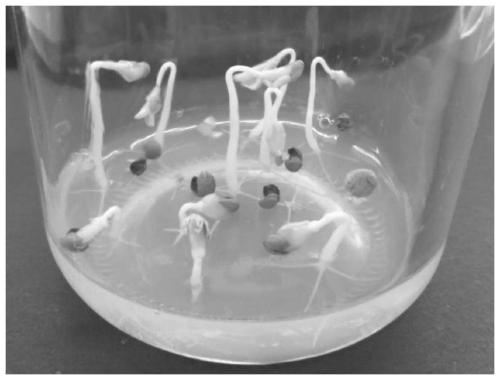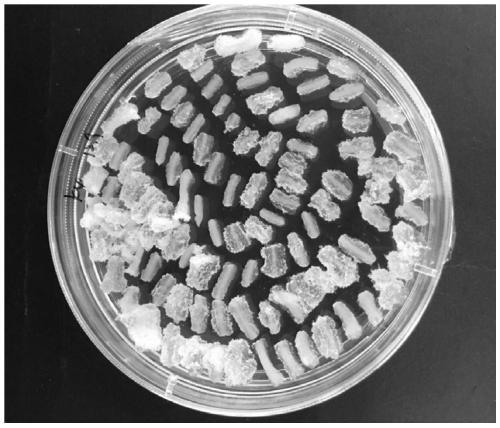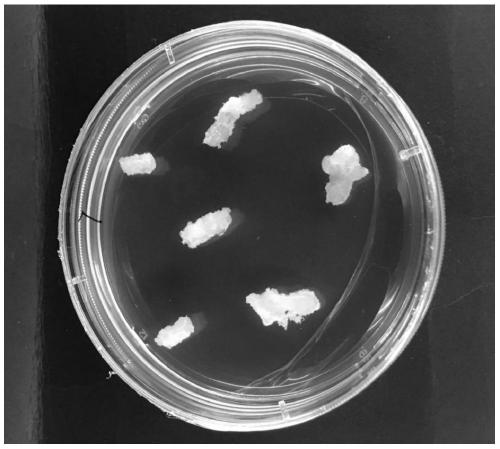Preparation and transformation method of papaya callus agrobacterium transformation receptor
A technology of Agrobacterium transformation and callus, applied in the field of transgenics, can solve the problems of lack of papaya, offspring separation, complex papaya strain, etc., and achieve the effect of simple operation, stable transformation system, simple and efficient formula
- Summary
- Abstract
- Description
- Claims
- Application Information
AI Technical Summary
Problems solved by technology
Method used
Image
Examples
Embodiment 1
[0037] A kind of preparation method of papaya callus Agrobacterium transformation receptor
[0038] Include the following steps:
[0039] (1) Seed disinfection: Take 250 papaya seeds and place them in sterilized tissue culture bottles, ①, 75% ethanol for 1 min, and sterile water for 3 to 5 times, ②, 3.5% NaClO solution for 20 min, sterile water Wash for 3 to 5 times, ③, 0.1% mercury liter disinfection for 10 minutes, and wash with sterile water for 3 to 5 times, ④, put the seeds into a sterilized Erlenmeyer flask with sterile tweezers, and add 100ml of 25% NaClO solution , put into 28, 180rpm shaker for 4h;
[0040] (2) 1M KNO3 treatment: take the seeds obtained in step (1), take them out from the 25% NaClO solution, wash them with sterile water for 3 to 5 times, replace them with 1mol / L KNO3 solution, and place them at 28°C, 180rpm Shaker 24h.
[0041] (3) Change water for germination: take the seeds obtained in step (2), take them out from the 1mol / L KNO3 solution, wash t...
Embodiment 2
[0050] Target gene vector construction
[0051] The recombinant vector containing the 35s-CpYh-1 target gene is constructed according to the method comprising the following steps: using the cDNA of sunup variety papaya as a template, using primers 35s-CpYh-1F and 35s-CpYh-1R to carry out PCR amplification, and The 735bp fragment of the amplified product (such as Figure 8 shown) was inserted between the M13 universal primers of the plasmid pMC202 (purchased from the ABRC official website) vector by homologous recombination to obtain the recombinant vector pMC202-35s-CpYh-1, and the primers HYG-F / R and primer 35s for the recombinant vector -CpYh-1F / R amplification confirms that the vector is constructed successfully (such as Figure 9 shown).
[0052] The nucleotide sequence of the target gene 35s-CpYh-1 is shown in SEQ ID NO.01:
[0053]
[0054]
[0055] The target gene 35s-CpYh-1 belongs to the transcription factor ZF-HD (Zinc-finger homeodomain), which plays an imp...
Embodiment 3
[0062] Agrobacterium-mediated papaya transformation method of papaya callus
[0063] Include the following steps:
[0064] 1. Infection: the OD value of the Agrobacterium infection solution containing the target gene prepared by the embodiment 2 suspended in 1 / 2 MS liquid medium is adjusted to 0.5~0.8, and the papaya prepared in Example 1 is healed with the infection solution Wounded tissue (ie papaya callus Agrobacterium transformed receptor) was shaken and soaked for 15-20 minutes (shaking infection for 3-4 minutes, resting for 11-17 minutes). Settle the callus upright, pour off the supernatant, blot the callus dry with filter paper, and blow it for 10 minutes, but don't blow it for too long.
[0065] 2. Co-cultivation: Put the infected callus on Ci medium and add sterile filter paper to co-cultivate in the dark room for 24 hours. If Agrobacterium visible to the naked eye is seen, it needs to be washed. The cultured callus was blow-dried in an ultra-clean bench.
[0066] ...
PUM
 Login to View More
Login to View More Abstract
Description
Claims
Application Information
 Login to View More
Login to View More - R&D
- Intellectual Property
- Life Sciences
- Materials
- Tech Scout
- Unparalleled Data Quality
- Higher Quality Content
- 60% Fewer Hallucinations
Browse by: Latest US Patents, China's latest patents, Technical Efficacy Thesaurus, Application Domain, Technology Topic, Popular Technical Reports.
© 2025 PatSnap. All rights reserved.Legal|Privacy policy|Modern Slavery Act Transparency Statement|Sitemap|About US| Contact US: help@patsnap.com



